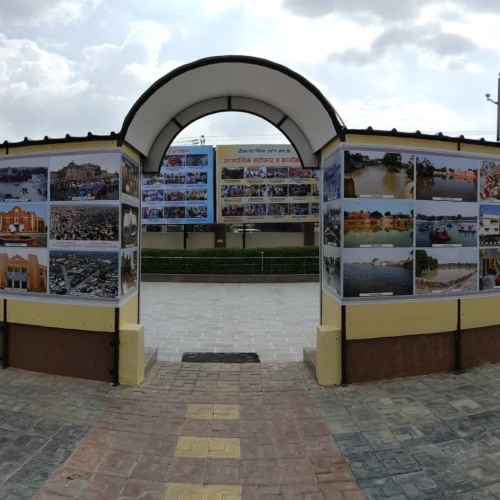Rajasthan’s Desert Blossoms: India Halts Pakistan-Bound Water, Stores It in Bikaner Reservoirs – A Strategic and Historic Shift After Operation Sindoor
By Defence Journalist Sahil | T.I.N. Network
Bikaner | Rajasthan’s desert is blossoming with new hope.
For centuries, Rajasthan’s desert has symbolized struggle—drought, famine, and the endless shortage of water. Life here was always measured in drops, carried from miles away. Every monsoon, eyes turned to the clouds, praying for relief. But history is now being rewritten. The land that once fought for survival is moving towards hope and self-reliance. The credit goes to a remarkable feat of water engineering—the Indira Gandhi Canal Project (IGNP)—and to newly constructed reservoirs that now store the very water which earlier flowed wastefully into Pakistan and the Arabian Sea.
This transformation is not just technical—it is civilizational. The desert, once seen as barren and merciless, now glimmers with the reflections of vast reservoirs. This is not merely a spectacle of beauty, but a profound declaration: Rajasthan’s Thar is now scripting its own destiny with water sovereignty.
A Dream Rooted in History
The Indira Gandhi Canal is no ordinary canal. Conceived after independence and named after Prime Minister Indira Gandhi, it is one of the longest irrigation canals in the world, stretching over 650 kilometers. It was designed to carry waters of the Sutlej-Beas rivers from Punjab and transform more than 28 lakh hectares of barren land into fertile fields.
Yet, for decades, much of this water, particularly in surplus seasons, went to waste. It either flowed into Pakistan, irrigating its fields, or ultimately drained into the Arabian Sea, while Rajasthan remained thirsty. This was not just an economic loss but a strategic challenge—India’s water was greening Pakistani soil while Rajasthan battled scarcity.
The new reservoirs are the decisive answer to this historical imbalance.
The Reservoir Revolution
Four strategically built reservoirs under the IGNP have changed Rajasthan’s water story:
- 504 RD Reservoir, Bikaner – Capacity: 2,000 MCM
- 750 Head Reservoir, Bikaner – Capacity: 3,000 MCM
- Jaisalmer Reservoir – Capacity: 1,500 MCM
- Phalodi (Jodhpur) Reservoir – Capacity: 2,300 MCM
Together, these four giants can store 8,800 million cubic meters (MCM) of water. This capacity is enough to irrigate millions of acres, provide drinking water to towns, and recharge the depleted groundwater of the Thar Desert.
Most remarkable among them is the 504 RD Reservoir in Bikaner, which has already stored nearly 1,300 MCM—65% of its total capacity. For the desert, this is nothing short of a miracle.
Vivek Goyal, Chief Engineer of IGNP Bikaner, said: “The very water that once flowed wastefully is now our lifeline. The 504 RD Reservoir reaching 65% of its capacity is the clearest proof of this initiative’s success.”
Operation Sindoor – The Turning Point
This achievement became possible only after Operation Sindoor, India’s decisive initiative to secure water resources during recent border tensions. Irrigation experts, the Indian Army, and civil engineers worked together to ensure that every drop of water under India’s right would now be stored and redirected.
The filling of these reservoirs is not merely an irrigation milestone—it is a strategic declaration: India will no longer allow its water to flow unchecked into Pakistan. It will now fuel fields, livelihoods, and prosperity within its own borders.
504 RD Reservoir – The Lifeline of the Desert
The 504 RD Reservoir is not just an engineering structure—it is a symbol. Constructed at a cost of ₹211 crore, with a base level of 173.48 meters and a full water level of 176 meters, it represents the fusion of precision engineering and ecological necessity.
Where once dust storms raged, water bodies now shimmer. For villagers, this is an unbelievable sight. For farmers, it is the dawn of secure crop cycles. And for Rajasthan, it is the living emblem of hope.
Assistant Engineer Lalit Kishore said: “Reservoirs like 504 RD will be a blessing for generations to come. They will revive groundwater and give farmers permanent relief.”
From Scarcity to Prosperity – The Social Impact
For decades, villages in Rajasthan suffered migration. Families moved to cities in search of work because farming here could not sustain life. Now, that story is changing.
The reservoirs have opened avenues for fisheries, eco-tourism, and bird sanctuaries. Migratory birds that once abandoned this barren land are returning. Rural youth are finding employment opportunities near their own villages.
Executive Engineer Sandeep Bhati noted: “These reservoirs will allow us to preserve water long-term. They will not only solve drinking and irrigation issues but also open new doors through fisheries and tourism. This will be a game-changer for the local economy.”
Strategic Significance of Water Sovereignty
The importance of this achievement goes far beyond economics. For decades, Rajasthan’s water benefitted Pakistani fields. By storing it within India, New Delhi has not only secured the future of its farmers but also reinforced its national interests.
In the 21st century, when water is called “Blue Gold” and is fast becoming a matter of global security, India’s step is a sign of foresight. Every stored cubic meter is now both an economic asset and a geopolitical statement.
Ecology and Groundwater Recharge
These reservoirs also hold a quiet but vital promise: groundwater revival. For years, water tables kept dropping, forcing farmers to dig deeper borewells. Now, with steady storage and natural seepage, aquifers will recharge. Wells and tube wells in surrounding villages will come alive again, reducing irrigation costs.
Where once sandstorms swept across, greenery is spreading. Pastoral communities, once crippled by lack of fodder, will now benefit from revived grazing lands.
Looking Ahead
The journey from scarcity to prosperity has only begun, but its foundation is strong. With 8,800 MCM of water stored, Rajasthan is moving towards a future where famine will be the exception, not the rule.
Agriculture, tourism, industry, ecology, and national security—all stand to gain strength from this water revolution. And as India asserts control over every drop of its rightful waters, Rajasthan’s desert will no longer be known only for its scorching sun, but also for its shimmering reservoirs.
The sands of Thar are no longer lifeless. They are writing a story of renewal—where dunes now reflect not despair, but the radiance of hope and prosperity.
पाकिस्तान का पानी रोककर लहलहाएगी राजस्थान की मरुधरा , पाकिस्तान की सरहद तक नहीं पहुंचेगा पानी, बीकानेर के दो रिजर्वायर में पाकिस्तान का रोका हुआ पानी , एक रिजर्वायर में 5700 करोड़ लीटर पानी, ऑपरेशन सिंदूर के बाद बड़ा फैसला
बीकानेर | राजस्थान का रेगिस्तान नई उम्मीदों से लहलहा रहा है
सदियों से राजस्थान का रेगिस्तान संघर्ष का प्रतीक रहा है—सूखा, अकाल और पानी की निरंतर कमी। यहाँ जीवन हमेशा बूँदों में मापा जाता था, जिन्हें लोग मीलों दूर से ढोकर लाते थे। हर मानसून बादल की ओर टकटकी लगाकर दुआएं की जाती थीं। लेकिन अब इतिहास बदल रहा है। scarcity से जूझती धरती अब उम्मीद और आत्मनिर्भरता की ओर बढ़ रही है। इसका श्रेय जाता है पानी इंजीनियरिंग की एक अद्भुत उपलब्धि—इंदिरा गांधी नहर परियोजना (IGNP)—और उन नए जलाशयों को, जिन्होंने अब उस पानी को संजोना शुरू कर दिया है जो पहले पाकिस्तान और अरब सागर की ओर बेकार बह जाता था।
यह बदलाव केवल तकनीकी नहीं है—यह सभ्यता का टर्निंग प्वाइंट है। रेगिस्तान, जो अब तक बंजर और कठोर माना जाता था, आज विशाल जलाशयों की चमकती हुई परछाइयों से दमक रहा है। यह दृश्य केवल सुंदरता का प्रतीक नहीं बल्कि एक गहरी घोषणा है: राजस्थान का थार अब पानी की संप्रभुता के साथ अपना भाग्य खुद लिख रहा है।
इतिहास में जड़ें जमाया हुआ एक सपना
इंदिरा गांधी नहर कोई साधारण नहर नहीं है। आज़ादी के बाद इसकी परिकल्पना की गई थी और इसे प्रधानमंत्री इंदिरा गांधी के नाम पर रखा गया। यह विश्व की सबसे लंबी सिंचाई नहरों में से एक है, जिसकी लंबाई 650 किलोमीटर से अधिक है। पंजाब की सतलुज-ब्यास नदियों से पानी लाकर यह नहर प्रणाली 28 लाख हेक्टेयर से अधिक बंजर भूमि को उपजाऊ बनाने के लिए बनाई गई थी।
लेकिन दशकों तक इस पानी का एक बड़ा हिस्सा, खासकर surplus सीजन में, व्यर्थ बह जाता था। या तो यह पाकिस्तान की ओर बहकर वहाँ की ज़मीन को सींचता या अंततः अरब सागर में मिल जाता, जबकि राजस्थान प्यासा रह जाता। यह सिर्फ़ आर्थिक नुकसान नहीं बल्कि रणनीतिक चुनौती भी थी—भारत का पानी पाकिस्तान के खेतों को हरा-भरा करता रहा और राजस्थान सूखे से जूझता रहा।
आज बने ये जलाशय उस ऐतिहासिक असंतुलन का निर्णायक जवाब हैं।
जलाशयों की क्रांति
IGNP प्रणाली पर रणनीतिक रूप से बनाए गए चार विशाल जलाशयों ने राजस्थान की जलकथा ही बदल दी है:
504 आरडी जलाशय, बीकानेर – क्षमता: 2,000 एमसीएम
750 हेड जलाशय, बीकानेर – क्षमता: 3,000 एमसीएम
जैसलमेर जलाशय – क्षमता: 1,500 एमसीएम
फलोदी (जोधपुर) जलाशय – क्षमता: 2,300 एमसीएम
कुल मिलाकर ये चार जल दिग्गज 8,800 मिलियन क्यूबिक मीटर (एमसीएम) पानी संग्रहित कर सकते हैं। यह पानी लाखों एकड़ खेतों को सिंचित करने, शहरों को पीने का पानी देने और थार के रेगिस्तान की सूख चुकी भूजल परतों को पुनर्जीवित करने के लिए पर्याप्त है।
इनमें सबसे अहम है 504 आरडी जलाशय बीकानेर का। वर्तमान में इसने पहले ही लगभग 1,300 एमसीएम पानी संग्रह कर लिया है—यानि अपनी कुल क्षमता का 65%। रेगिस्तान के लिए यह पहली बार हुआ ऐतिहासिक चमत्कार है।
आईजीएनपी बीकानेर के मुख्य अभियंता विवेक गोयल ने कहा: “जो पानी पहले व्यर्थ बहकर चला जाता था, वही अब हमारी जीवनरेखा बन रहा है। 504 आरडी जलाशय का 65% भर जाना इस पहल की सफलता का सबसे बड़ा सबूत है।”
ऑपरेशन सिंदूर – निर्णायक मोड़
यह उपलब्धि ऑपरेशन सिंदूर के बाद ही संभव हुई। यह भारत की निर्णायक पहल थी, जिसमें हाल के सीमा तनाव के दौरान जल प्रबंधन को सुरक्षित किया गया। राजस्थान के सिंचाई विशेषज्ञों, भारतीय सेना और सिविल इंजीनियरों ने मिलकर यह सुनिश्चित किया कि भारत के अधिकार का हर बूँद पानी अब संग्रहित और पुनर्निर्देशित किया जाएगा।
यह reservoir भरना केवल सिंचाई का मील का पत्थर नहीं है—यह रणनीतिक घोषणा है: भारत अब अपना पानी पाकिस्तान की ओर अनियंत्रित नहीं बहने देगा। यह पानी अब खेतों को हरा-भरा करेगा और scarcity को surplus में बदलेगा।
बीकानेर का 504 आरडी जलाशय – रेगिस्तान की जीवनधारा
504 आरडी जलाशय केवल एक संरचना नहीं बल्कि एक संदेश है। ₹211 करोड़ की लागत से निर्मित, इसका बेस लेवल 173.48 मीटर और पूर्ण जलस्तर 176 मीटर है। यह इंजीनियरिंग की सटीकता और पर्यावरणीय आवश्यकता का अनूठा संगम है।
आज जहाँ कभी धूल उड़ती थी, वहाँ अब पानी की झीलें चमक रही हैं। गाँव वालों के लिए यह दृश्य अविश्वसनीय है। किसानों के लिए यह सुरक्षित कृषि चक्र की शुरुआत है। और पूरे राजस्थान के लिए यह उम्मीद का सजीव प्रतीक है।
सहायक अभियंता ललित किशोर ने कहा: “504 आरडी जैसे जलाशय आने वाली पीढ़ियों के लिए वरदान साबित होंगे। ये भूजल को पुनर्जीवित करेंगे और किसानों को स्थायी राहत देंगे।”
कमी से समृद्धि तक – सामाजिक प्रभाव
राजस्थान के गाँव वर्षों से पलायन की पीड़ा झेलते रहे हैं। लोग शहरों की ओर काम की तलाश में निकल जाते थे क्योंकि खेती यहाँ जीवन नहीं चला सकती थी। लेकिन अब यह कहानी बदल रही है।
स्थायी जलाशयों के कारण मत्स्य पालन की योजनाएँ बन रही हैं। ईको-टूरिज्म और पक्षी अभयारण्यों की संभावनाएँ उभर रही हैं। वे प्रवासी पक्षी, जो इस बंजर भूमि को छोड़ देते थे, अब लौटने लगे हैं। ग्रामीण युवाओं को अब रोज़गार के अवसर अपने ही गाँव के पास मिलने लगे हैं।
कार्यकारी अभियंता संदीप भाटी ने कहा: “इन जलाशयों से हम लंबे समय तक पानी सुरक्षित रख सकेंगे। यह न सिर्फ़ पेयजल और सिंचाई की समस्या सुलझाएगा बल्कि मत्स्य पालन और पर्यटन जैसे नए अवसर खोलेगा। यह स्थानीय अर्थव्यवस्था के लिए गेम चेंजर साबित होगा।”
जल संप्रभुता का रणनीतिक संदेश
यह उपलब्धि केवल आर्थिक नहीं बल्कि रणनीतिक दृष्टि से भी अत्यंत महत्वपूर्ण है। दशकों तक राजस्थान का पानी पाकिस्तान के खेतों को लाभ पहुँचाता रहा। अब, इसे भारत की सीमा में संग्रहित करके, नई दिल्ली ने न केवल किसानों का भविष्य सुरक्षित किया है बल्कि राष्ट्रीय हितों को भी मजबूत किया है।
21वीं सदी में जब पानी को “ब्लू गोल्ड” कहा जा रहा है और यह वैश्विक सुरक्षा का मुद्दा बन चुका है, भारत का यह कदम दूरदर्शिता का प्रतीक है। हर संग्रहित क्यूबिक मीटर अब आर्थिक संपत्ति भी है और भू-राजनीतिक बयान भी।
पारिस्थितिकी और भूजल पुनर्जीवन
इन जलाशयों का एक और मौन लेकिन अहम प्रभाव भूजल पर होगा। वर्षों से भूजल परतें घटती जा रही थीं और किसान गहरे बोरवेल खोदने को मजबूर थे। अब स्थायी जलाशय प्राकृतिक रिसाव और रिचार्ज का माध्यम बनेंगे। इससे आस-पास के गाँवों में कुएँ और नलकूप फिर से जीवित होंगे और सिंचाई की लागत घटेगी।
जहाँ कभी रेत के तूफ़ान उठते थे, वहाँ अब हरियाली फैलने लगी है। पशुपालक समुदाय, जो चारे की कमी से जूझते थे, अब सिंचाई से revived चारागाहों का लाभ उठाएँगे।
भविष्य की ओर दृष्टि
कमी से समृद्धि की यात्रा अभी शुरुआती दौर में है, लेकिन नींव मजबूत रखी जा चुकी है। 8,800 एमसीएम पानी संग्रहित होने के साथ, राजस्थान अब उस भविष्य की ओर बढ़ रहा है जहाँ अकाल अपवाद होगा, नियम नहीं।
खेती, पर्यटन, उद्योग, पारिस्थितिकी और राष्ट्रीय सुरक्षा—सभी को इन जलाशयों से नई ताकत मिलेगी। और जैसे-जैसे भारत अपने हर बूँद पानी पर अधिकार जताएगा, राजस्थान का रेगिस्तान अब केवल तपते सूरज से नहीं बल्कि चमकते जलाशयों से भी पहचाना जाएगा।
थार की रेत अब निर्जीव नहीं रही। यह पुनर्जीवन की कहानी लिख रही है—जहाँ धोरों पर अब निराशा नहीं बल्कि उम्मीद और समृद्धि की चमक दिखाई दे रही है।













Add Comment